Revolutionary muscle discovery
This is HUGE news for bodybuilders and strength trainers if it is true. It appears that the model of the muscle we have been using for over 50 years is probably wrong. Our understanding of how muscles generate power has been transformed by the July 10 in the Royal Society journal Proceedings of the Royal Society B. The Royal Society is the U.K.’s national academy of sciences. They used x-ray diffraction and 3D computer modeling on moths in their research. Myosin pulling on actin still shorten, or contract, the muscle — but the power doesn’t just come from pulling on the endpoints of the “rubber band” as previously thought. If this research turns out to be correct, muscle is more like a mesh than a bundle of fibers and can pull side to side as well as axially. This new research helps explain the discrepancy of why muscles can produce more force than the simple axial model suggests. So basically they are proposing replacing the old rubber band muscle model with the muscle-blob muscle model where the muscle blob can pull side to side on its neighbors as well as linearly between the endpoints.
What this means to bodybuilders
First it means that I would need to eat humble pie and admit I am wrong. For years I have said there there is no way to shape muscles like biceps and that it was simple genetics and locations of insertions that determined shapes. I have also said that there is no way to focus on the inner pec or the outer pec. If this research is correct, it means that you CAN shape muscles. Why? If the muscle is a simple rubber band like the current model suggests, then you can only make the fiber bigger. I make a big deal of this in my discussion of inner and outer pecs. If the muscles are not an independent bunch of rubber bands bound together in a sheath, then everything is changed and shaping would be possible.
The outcome of this research could also have great implications for helping us learn how to optimally build strength and muscle mass. It could shed light on optimal range of motion. The old “length-tension curve” model from the 50’s will certainly be refined by this research.
Thanks to member Autodafe on the AskScooby forum for finding this important research

